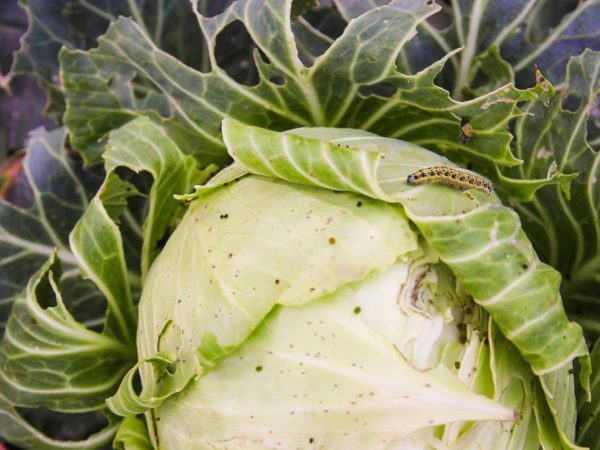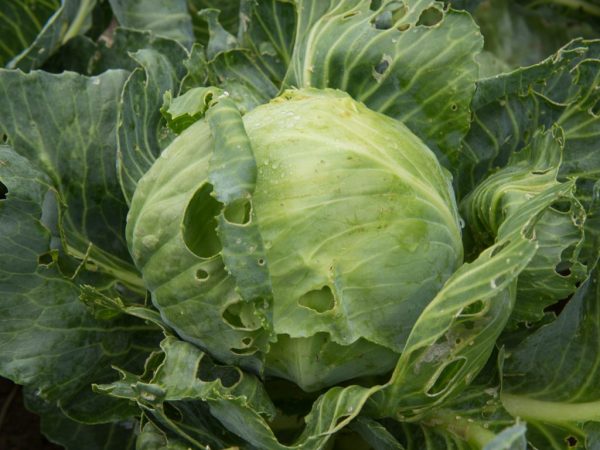Fighting caterpillars on cabbage
Cabbage foliage is often affected by pests, among which caterpillars are found. The fight against caterpillars on cabbage is carried out in different ways, each gardener chooses the most preferable one or uses complex measures.

Fighting caterpillars on cabbage
Cabbage caterpillars
Consider what types of caterpillars on cabbage leaves are dangerous.
Caterpillars of Cabbage White
Cabbage white butterfly is a white butterfly with a black border on the tips of its wings. She lays eggs in May, they can be found on the inside of cabbage leaves. The larvae of this pest are gray-green in color, lined with yellow stripes and black spots. As a rule, the caterpillars of the cabbage whitebird settle on the upper side of the leaves, eating greens and leading to a delay in plant development.
Repnitsa caterpillars
The daytime butterfly is similar in appearance to the whitewash, only it has a smaller size. Its larvae are velvety, with a green coloration and a yellow stripe. They eat cabbage leaves and spoil heads of cabbage.
Caterpillars of the scoop
The cabbage scoop is a small nocturnal butterfly. It is nondescript, dull gray in color. Its larvae are green and settle inside the cabbage head. In the daytime, they climb out onto the leaves.
Caterpillars of cabbage moth
The night cabbage moth appears in April and lives on cabbage plantings until July. In a gray-brown butterfly with a light pattern, very small larvae with a green color appear, which settle on cabbage foliage.
Folk methods of struggle
Usually, most gardeners start the fight using folk methods that do not harm future vegetables.
Attracting natural enemies
Summer residents, in order to get rid of caterpillars on cabbage, prefer to attract natural enemies to the beds (for example, ants and wasps). You can lure beneficial insects to the site with the help of sweet liquids, if you water the beds with cabbage plantings with them.
Ladybugs and beetles are not averse to feasting on the larvae of butterflies, which can be attracted by fragrant peduncles.
Eggshell

Folk remedies help get rid of insects
The use of eggshells is a trick against harmful whites, laying eggs on landings. Gardeners lay out the shells on cabbage leaves, which the butterfly takes for another insect, and does not settle in the occupied territory.
Smelly neighbors
Planting plants with a pungent smell near vegetables also helps to get rid of caterpillars in cabbage and scare away pests. Garlic and onions, potatoes and tomatoes, coriander and lovage, calendula and marigolds have such properties in the fight against butterflies and their larvae.
Instead of planting plants, you can resort to watering cabbage beds with infusions made on them.To prepare a saturated solution, you need about 2-3 kg of tomato or potato tops, a dozen garlic heads and a 200-milliliter jar of onion husks. All this is insisted for a day, and then cabbage plantings are sprayed. Soap is added for better grip.
Vinegar and ammonia
Vinegar essence with a concentration of 9% helps to effectively control pests. Cabbage beds are watered with a solution of 2 tbsp. l. vinegar diluted in a 10 liter volume of water.
Liquid ammonia has the same properties. For the same volume, 50 g is required.
Baking soda
To destroy the larvae that have settled on the leaves of cabbage, simple baking soda allows, if it is mixed with flour in equal proportions, sprinkled with cabbage heads.
Mechanical methods
It is possible to fight pests in a simple mechanical way, manually collecting insects and burning them.
Biological methods
Recently, microbiological preparations have appeared for the control of pests and their larvae on cabbage. Their advantage is safety for plants and animals. Their main action is aimed at infecting harmful insects with one of the types of microbes, leading to the death of pests.
The use of microbiological preparations simultaneously helps in the fight against fungal and bactericidal infections.
Entobacterin is a microbiological drug against insects. For the processing of cabbage plantings, 50 g per 10 liters of water is enough.
The drug is used at a temperature of 18 ° C - 30 ° C. At lower temperatures, microorganisms that destroy pests are not capable of growth and reproduction. The frequency of spraying cabbage with entobacterin is at least 2 times a week. The use of the drug is discontinued a week before harvest.
Other preparations with a microbiological nature:
- "Lepidocide" and "Fitoverm" are effective agents against all harmful insects and their larvae,
- "Bitoxibacillin" is used in the fight against cabbage and turnip.
Chemicals
In advanced cases, when there is a massive defeat of cabbage plantings by pests, it is possible to get rid of caterpillars on cabbage only with the use of chemicals. Today there is a wide range of chemical insecticidal products for insect control. They are diluted with water and used for spraying:
- Splender. The rate of use is 25 g per 1 liter.
- Trifluurex. The rate of use is 240 g per 1 liter.
- "Decis extra". The rate of use is 125 g per 1 liter.
- "Butizan". The rate of use is 400 g per 1 liter.


